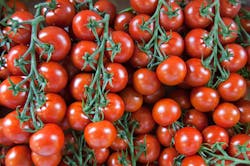Signify and Dutch university recommit to horticultural research
Horticultural lighting sales remain stuck in neutral, but research keeps rolling along. In the latest example, Signify said that it has renewed its collaboration with Holland’s Wageningen University & Research, and that the two groups are investigating more energy-efficient deployments of LEDs.
The Dutch lighting giant said it will continue to provide LED lighting to WUR’s Innovation & Demonstration Center in Bleiswijk, which is about 50 miles west of WUR’s central location in Wageningen. WUR’s mission is to apply natural sciences, including horticulture, to improve the quality of life.
WUR’s Bleiswijk location includes three greenhouses, one with four compartments for high-wire cultivation, and two others with a total of 26 cultivation tables. WUR conducts experiments with LED grow lights tuned to different intensities and spectra for various crops.
Eindhoven-based Signify has been working with WUR since 2013 on a variety of studies and projects in Bleiswijk and elsewhere, including installing red streetlights in a Dutch town to nurture bat life.
Signify did not reveal the duration of its renewed commitment, but it provided a taster of ongoing joint research. The two outfits are examining different practices that reduce the energy consumption of LED lighting. One tomato study showed that lights can be dimmed at times — rather than kept on at full intensity — with little detriment to growth. The same study showed that turning lights off altogether and then back on was far less effective than dimming, because it led to lower chlorophyll count, less photosynthesis, and lower weight.
Signify said it would reveal more details of the study at a later date.
Although LEDs are known for low energy consumption, their use in greenhouses that had not previously employed artificial lighting represents a significant increase in energy costs for growers, who are forgoing purchases as energy prices remain high. That is one reason why the horticultural lighting business is in the doldrums. Signify CEO Eric Rondolat recently described a “missed season” in the sector.
WUR collaborates with other LED lighting companies in addition to Signify. It recently worked at the chip level with ams Osram to examine the effects of red spectra. It has also worked with GE Current to examine the effects of interlighting on tomatoes.
MARK HALPER is a contributing editor for LEDs Magazine, and an energy, technology, and business journalist ([email protected]).
Follow our LinkedIn page for our latest news updates, contributed articles, and commentary, and our Facebook page for events announcements and more. You can also find us on the X platform.

Mark Halper | Contributing Editor, LEDs Magazine, and Business/Energy/Technology Journalist
Mark Halper is a freelance business, technology, and science journalist who covers everything from media moguls to subatomic particles. Halper has written from locations around the world for TIME Magazine, Fortune, Forbes, the New York Times, the Financial Times, the Guardian, CBS, Wired, and many others. A US citizen living in Britain, he cut his journalism teeth cutting and pasting copy for an English-language daily newspaper in Mexico City. Halper has a BA in history from Cornell University.





